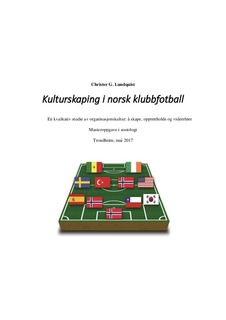| dc.description.abstract | The subject of this study is the creation and transmission of culture to new members of differing ethnic backgrounds in football clubs, despite a lack of continuity in membership. While football clubs are widely known for high player turnover, they still manage to quickly establish and maintain a team structure that allow for high-level performance on the pitch. Based on the idea that a strong culture must have continuity in membership, my hypothesis is that I will find elements in the culture of football clubs that could give new and valuable insights into the intricacies of integration. In order to examine these potential benefits, I have utilized a qualitative design consisting of in-depth-interviews and observations within a Norwegian football club. The interviews were conducted with a strategic selection of four soccer players and three staff members, alongside two days of participatory observation. My leading research question for the entirety of the study have been the following: “How does a Norwegian football club transfer and maintain its culture in a social environment in which players of differing ethnic backgrounds are frequently replaced?”
My primary finding is that the football club subject to study have strong social structures embodying elements of integration, inclusion and confirmation, to which I will be refering as “systems of integration” (“integreringssystemer”). These systems are working at such high intensity that it compensates for high player turnover, allowing the culture to quickly be transmitted to new players. Two key factors for continuity in these systems are high frequency and direct confirmation.Upon uncovering how the culture in the Norwegian football club is transmitted and maintained, I decided to argue that the two terms “Weak” and “Strong Culture” insufficiently describes the trades of the football club. I decided to include the two terms “Authentic” and “Synthetic Culture” in ordet to adress the differentiation between turnover on one hand, and systems of integration. The typology presented in the latter part of the study, my “Model for the transmission and maintenance of culture”, illustrates this differentiation.
As a conclusive note, I recommend that organizations which want to improve their systems of integration should examine the assumptions that form the basis of the organization in order to create a collective affiliation. | nb_NO |
